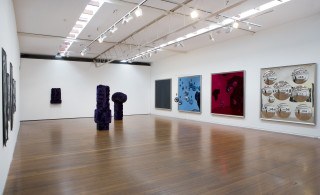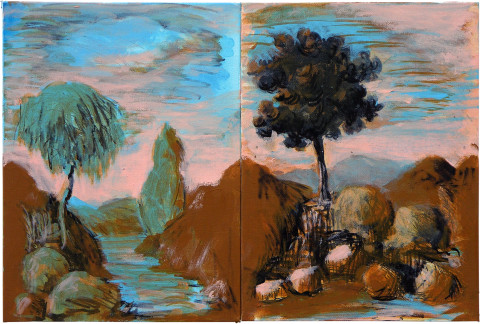Tony Clark’s Myriorama paintings have been a recurrent feature of his practice for twenty years, each time appearing in a different guise, transformed conceptually by shifts in palette, form and configuration.
Exhibition Dates: 2 March – 25 March 2006
In 1824, an English artist named John Clark published a game —a gentle conceit on the theme of landscape. Sixteen small panels depicted fragments of an idealised landscape, the sort taught since the seventeenth century in the painting academies of Europe. Pieces of a rustic arcadia with its various trappings (flocks, hamlets, anglers etc.) could be assembled in any number of ways to form a panoramic scene. Due to the common horizon line bridging each panel, any panel could be placed adjacent to any other piece. Millions of configurations of Clark’s landscape scene were possible.
Ornamental systems and the deeply-embedded conventions of artistic representation have long been of interest to conceptual painter Tony Clark. Classicism has been particularly important for him because of the way it is a ‘bedrock’ for subsequent histories of European art. Landscape is abstracted. Architecture is inserted into landscape. Architectural decoration and other objects cue the viewer in their appreciation of a past ideal, guiding us through and instantiating elegy. In his paintings of the early 1980s, Clark chose the classical temple, the archetypal adornment of landscape as the subject of his paintings. Then in 1985, elaborating upon these primitive scenes, he removed the temple and began to play with the idea of ‘endless landscape’—which is, in a manner of speaking, what Classicism always was. Infinite/timeless ideal. Nineteenth-century Clark’s Myriorama provided the perfect model for the late-twentieth century artist. The younger Clark, took the device of interchangeability, removed all human presence (flocks, hamlets, anglers etc.) and presented a brooding horizon line dotted with generic tree silhouettes, rocks, furrows, water courses and ground. In this state, the landscape is both a classical landscape (with absent fictive architecture) and a frieze to interpret and articulate the actual architectural interior in which the painting is installed. With the one set of panels, the artist/viewer/collector has enormous flexibility not only in its horizontal arrangement but also in how it is configured on the vertical axis. Panorama becomes vertical column becomes grid. Tony Clark’s Myriorama paintings have been a recurrent feature of his practice for twenty years, each time appearing in a different guise, transformed conceptually by shifts in palette, form and configuration.
—
For over 25 years, Clark has occupied an important position in Australian contemporary art. This position has been partly characterized by his migratory lifestyle which has figured on various levels. Clark grew up with his parents in Rome until his late teens and then, after University in the , was based in Melbourne where he came to bridge the worlds of art, music and film. His friendships and professional connections with certain artists who are now icons of Australian contemporary culture - like the musicians Nick Cave and Ed Kuepper and the painter Howard Arkley - have involved him in many interesting projects that do not strictly speaking fall within the visual arts, but which operate at the cutting edge of a broader cultural horizon. He has collaborated on music projects, produced artwork for album covers and acted in films, including the Australian cult film, Ghosts … of the Civil Dead (1988), to which Cave also contributed in the form of script writing and a cameo appearance. For the past 10 years, Clark has moved between , the and . He has written widely on contemporary art (frequently under a pseudonym). Clark has also been honoured with some of the most prestigious callings for a contemporary artist, such as being included in Documenta in Kassel in 1992. In Documenta, Clark exhibited his early Myriorama landscapes now in the collection of the Museum of Contemporary Art, Sydney. A retrospective exhibition of his work, Tony Clark – Public and Private Paintings 1982-1998, was held at the Museum of Modern Art at Heide in Melbourne in 1998. Clark’s Myriorama paintings have been selected for both Unpacked collection exhibitions at the Museum of Contemporary Art, Sydney (in 2001 by filmmaker Jane Campion and in 2003 by indigenous artist, Julie Dowling). Tony Clark has been hugely influential on several generations of contemporary Australian artists. He has been exhibiting with Roslyn Oxley9 Gallery since 1983.

acrylic and permanent ink on canvas board
24 panels, overall dimensions 91 x 181 cm

acrylic and permanent ink on canvas board
12 panels, overall dimensions 91 x 91 cm

acrylic and permanent ink on canvas board
12 panels, overall dimensions 91 x 91 cm

acrylic and permanent ink on canvas board
4 panels, overall dimensions 30.5 x 90.5 cm

acrylic and permanent ink on canvas board
3 panels, overall dimensions 30.5 x 68 cm

acrylic and permanent ink on canvas board
3 panels, overall dimensions 30.5 x 68 cm

acrylic and permanent ink on canvas board
3 panels, overall dimensions 30.5 x 68 cm

acrylic and permanent ink on canvas board
3 panels, overall dimensions 30.5 x 68 cm
 Group Show
Group Show
Roslyn Oxley9 Gallery, 2015
 Tony Clark Jesus
Tony Clark Jesus
Roslyn Oxley9 Gallery, 2014
 Tony Clark Buehnenbilder
Tony Clark Buehnenbilder
Roslyn Oxley9 Gallery, 2012
 Group Show, Groups Who
Group Show, Groups Who
Roslyn Oxley9 Gallery, 2011-12
 Tony Clark Shakespeare
Tony Clark Shakespeare
Roslyn Oxley9 Gallery, 2011
Group Show, Wilderness: Balnaves Contemporary Painting
Art Gallery of New South Wales, Sydney, 2010
 Group Show, Lucky Town
Group Show, Lucky Town
Roslyn Oxley9 Gallery, 2008-09
 Tony Clark Prix de Rome
Tony Clark Prix de Rome
Roslyn Oxley9 Gallery, 2008
 Group Show, STOLEN RITUAL
Group Show, STOLEN RITUAL
Roslyn Oxley9 Gallery, 2006-07
 Tony Clark Sections from Clark's Myriorama
Tony Clark Sections from Clark's Myriorama
Roslyn Oxley9 Gallery, 2006
 Group Show, If these walls could talk
Group Show, If these walls could talk
Roslyn Oxley9 Gallery, 2005
 Tony Clark Flowerpieces
Tony Clark Flowerpieces
Roslyn Oxley9 Gallery, 2003
 Group Show, The First 20 Years
Group Show, The First 20 Years
Roslyn Oxley9 Gallery, 2002
 Group Show, All Stars
Group Show, All Stars
Roslyn Oxley9 Gallery, 2000
 Tony Clark Lontano
Tony Clark Lontano
Roslyn Oxley9 Gallery, 2000
 Tony Clark The Strangeness of Panorama
Tony Clark The Strangeness of Panorama
Roslyn Oxley9 Gallery, 1997
 Group Show, Stockroom
Group Show, Stockroom
Roslyn Oxley9 Gallery, 1995
 Tony Clark Fashion, Decor, Interior
Tony Clark Fashion, Decor, Interior
Roslyn Oxley9 Gallery, 1995
 Tony Clark
Tony Clark
Roslyn Oxley9 Gallery, 1995
 Tony Clark Jasperware Paintings
Tony Clark Jasperware Paintings
Roslyn Oxley9 Gallery, 1994
 Tony Clark
Tony Clark
Roslyn Oxley9 Gallery, 1993
 Group Show
Group Show
Roslyn Oxley9 Gallery, 1992
 Group Show, Christmas show
Group Show, Christmas show
Roslyn Oxley9 Gallery, 1991
 Tony Clark Sections from Clark's Myriorama
Tony Clark Sections from Clark's Myriorama
Roslyn Oxley9 Gallery, 1991
 Group Show
Group Show
Roslyn Oxley9 Gallery, 1990
Tony Clark Bronze Reliefs, Chinoiserie Screens
Roslyn Oxley9 Gallery, 1988
 Group Show, 1968-1988 Selected works
Group Show, 1968-1988 Selected works
Roslyn Oxley9 Gallery, 1988
 Tony Clark Villa Sino-Romana
Tony Clark Villa Sino-Romana
Roslyn Oxley9 Gallery, 1987
 Group Show, The Forbidden Object
Group Show, The Forbidden Object
Roslyn Oxley9 Gallery, 1986
 Group Show, Dreams and Nightmares
Group Show, Dreams and Nightmares
Roslyn Oxley9 Gallery, 1984





